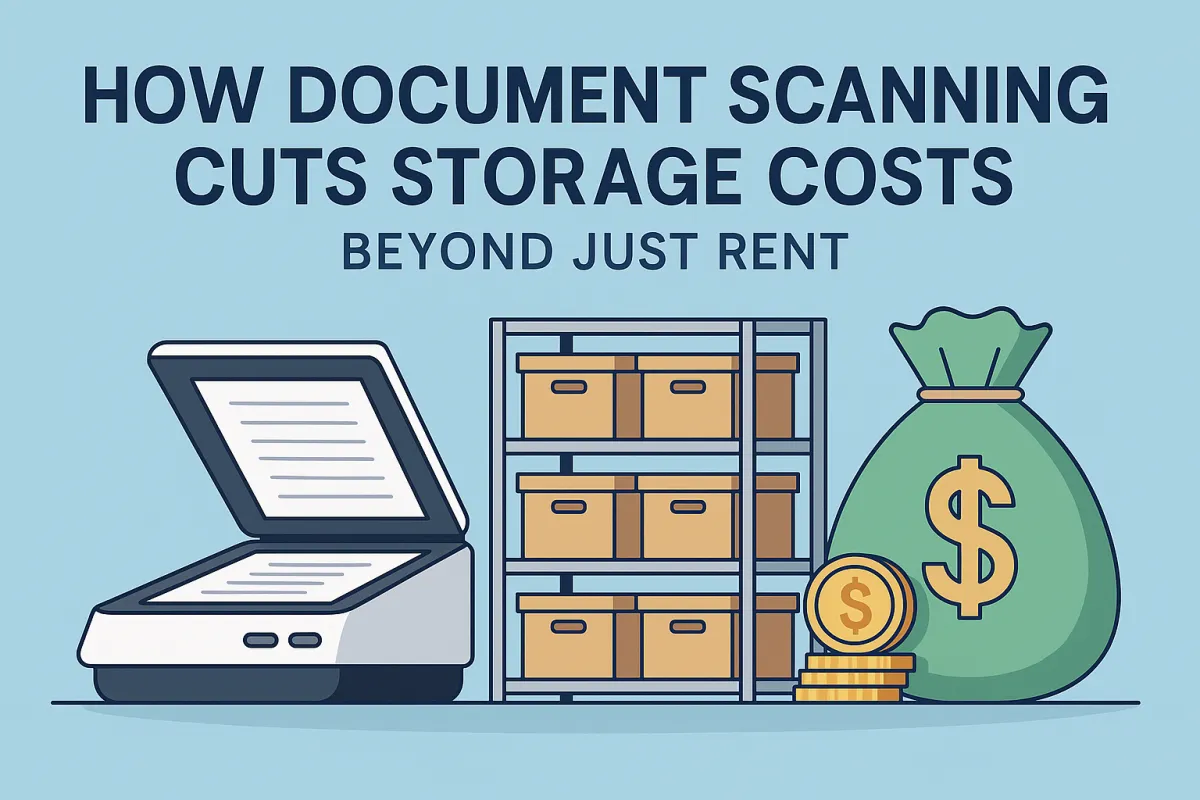
How Document Scanning Cuts Storage Costs Beyond Just Rent
By: USA IMAGING, Inc.
When most businesses think about storage costs, the first thing that comes to mind is rent—the square footage occupied by rows of file cabinets, banker’s boxes, or off-site storage units. While that’s certainly a major part of the expense, the real cost of physical document storage goes far beyond the monthly lease. From climate control to compliance, from security to wasted staff hours, paper records can quietly drain resources and expose your business to risk.
At USA IMAGING, Inc., we’ve seen firsthand how companies free themselves from these hidden expenses by scanning and digitizing their records. Let’s take a closer look at the true cost of physical storage—and how going digital saves more than you might think.
1. Rent and Space Allocation
Yes, rent is the obvious starting point. A single filing cabinet takes up about 15 square feet of office space when you account for access and walkways. Multiply that by dozens—or even hundreds—of cabinets, and suddenly you’re paying premium commercial rent just to store paper.
By digitizing, those cabinets disappear, freeing valuable square footage for revenue-generating activity: additional workstations, collaboration areas, or simply downsizing to a more cost-efficient office footprint.
2. Climate Control and Environmental Costs
Paper doesn’t store itself. Offices and warehouses must maintain stable temperature and humidity to prevent yellowing, mold, or ink fading. In many cases, HVAC systems run longer or harder to maintain optimal conditions.
Digital files? They don’t care if the office is 65° or 80°. By eliminating paper, you’re not only reducing physical storage needs but also lowering long-term utility bills.
3. Security and Access Control
Sensitive files—medical records, HR documentation, legal contracts—can’t just sit in an unlocked cabinet. Secure storage often means badge-restricted file rooms, locked cabinets, and even off-site facilities with guards and surveillance.
Scanning eliminates much of this overhead. Properly digitized records are encrypted, access is managed by user permissions, and detailed audit trails show exactly who opened what and when. Digital security is scalable, while physical security requires continuous labor and infrastructure costs.
4. Compliance and Liability
Non-compliance is a cost that few businesses think about until it’s too late. HIPAA fines, legal discovery delays, or audit penalties can run into the tens—or even hundreds—of thousands. Physical files are harder to track, harder to produce quickly, and easier to mishandle.
Digitized files, on the other hand, can be indexed for instant retrieval. When an auditor or attorney requests a document, staff can produce it in seconds, not days. This reduces the risk of fines, penalties, and damaged reputation.
5. Retrieval Time and Productivity
One of the most overlooked “storage costs” is employee time. Studies have shown that workers spend up to 20% of their day looking for information. Walking to file rooms, digging through boxes, re-filing—those minutes add up quickly.
OCR (Optical Character Recognition) and indexing change the game. Instead of losing hours searching through folders, employees can type a keyword and retrieve the right document instantly. That’s not just a cost savings—it’s a productivity multiplier.
6. Risk of Loss or Damage
Fire, flood, and theft are risks that never fully go away with paper. Even with insurance, the cost of lost or destroyed records is staggering, especially when it comes to legal liability or business continuity.
Digital files offer built-in redundancy. Cloud storage, secure backups, and disaster recovery protocols ensure that even in a worst-case scenario, your records are safe, accessible, and intact.
7. Hidden Overhead: Supplies and Management
Paper records require constant management—boxes, labels, shelving, replacement cabinets, and file clerks. Every reorganization means buying supplies, printing labels, or paying staff for tedious, repetitive work.
Once scanned, files don’t need re-labeling or moving. Digital structures can be reorganized with a few clicks—no heavy lifting, no re-boxing, no downtime.
The Real Savings Picture
When you add it all up, physical storage costs are like an iceberg: rent is the part you see above the surface, but climate control, compliance, security, risk, and staff time are the massive hidden portion underneath. Businesses that switch to scanning aren’t just saving on rent—they’re saving on operations, utilities, compliance, and headaches.
At USA IMAGING, Inc., we’ve helped companies of all sizes uncover these hidden costs and transition to a digital workflow that pays dividends year after year.
📞 Contact us today at 858-513-6565
💻 Request a quote: https://usa-imaging.com/get-a-quote
